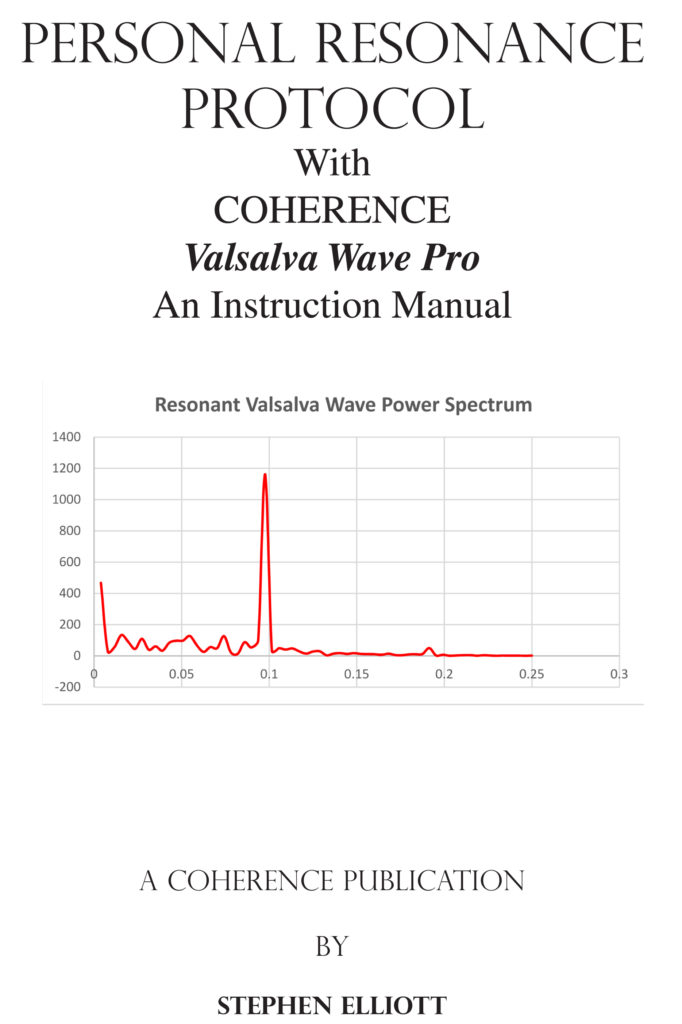Coherent Breathing Biofeedback With Valsalva Wave Pro, Release 2.0. Valsalva Wave Pro With Personal Resonance Protocol Renders Other HRV Biofeedback Products Obsolete.
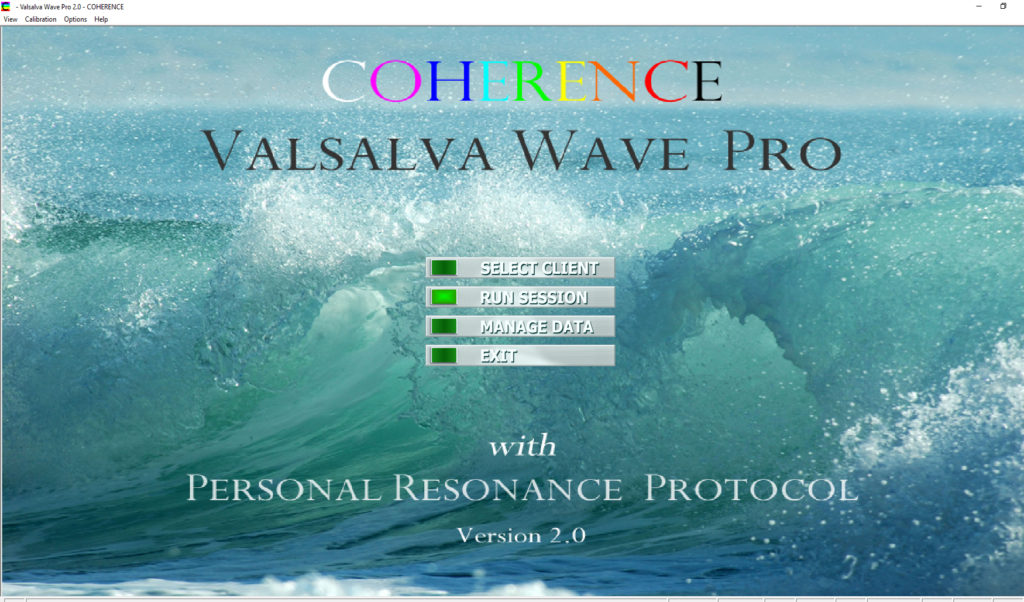
Valsalva Wave Pro 2.0 with Ear Sensor $1895.00 plus FREE shipping
Valsalva Wave Pro 2.0 with Finger Sensor $1950.00 plus FREE shipping
Ear Sensor only $225.00 plus $9.95 shipping.
Finger Sensor only $250.00 plus $9.95 shipping
Special Discount Available For Qualified Practitioner Directory Participants (See Practitioner Directory Menu)
Initially released in 2009, Valsalva Wave Pro allows us to monitor and train a fundamentally new biometric, the wholistic “Valsalva Wave”, a breathing induced blood wave that occurs with each cycle of respiration when we breathe “coherently”. COHERENCE holds the patent on its detection and feedback, US patent #7922664. VWave Pro is the only instrument of its kind, rendering HRV only instruments obsolete. With the release of Personal Resonance Protocol, Release 2.0 takes Valsalva Wave Pro to the next orbit – that of “personal resonance”, cutting the long standing gordian knot of how to detect and determine personal resonant frequency.
With Valsalva Wave Pro One Can Train Breathing Without A Chest Band, Even With Heart Arrhythmia.
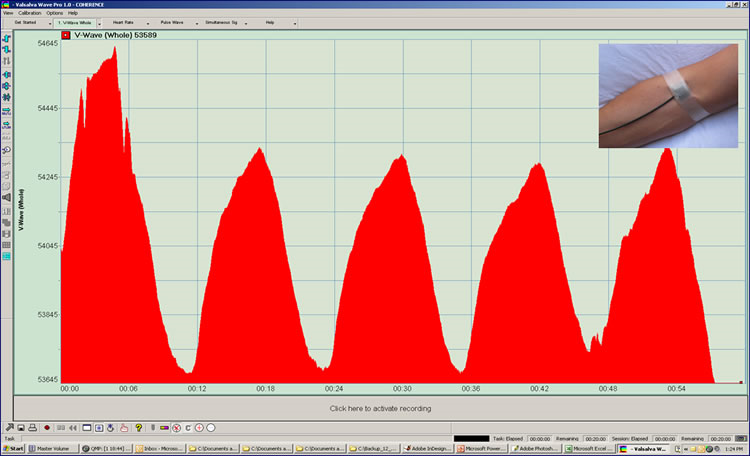
Venous return is almost immune to the heart beat. This is because breathing is the primary physiological force that causes blood to return to the chest, the large strong diaphragm facilitating a vacuum in the thoracic cavity inclusive of heart and lungs. Valsalva Wave Pro uses plethysmography to detect and monitor inhalation and exhalation in the venous return – no chest strap required to monitor breathing (where a chest strap is uncomfortable and inhibits free movement of the chest). Simply tape the sensor to the medial cubital vein and Valsalva Wave Pro automatically adjusts the presentation to the variation of interest.
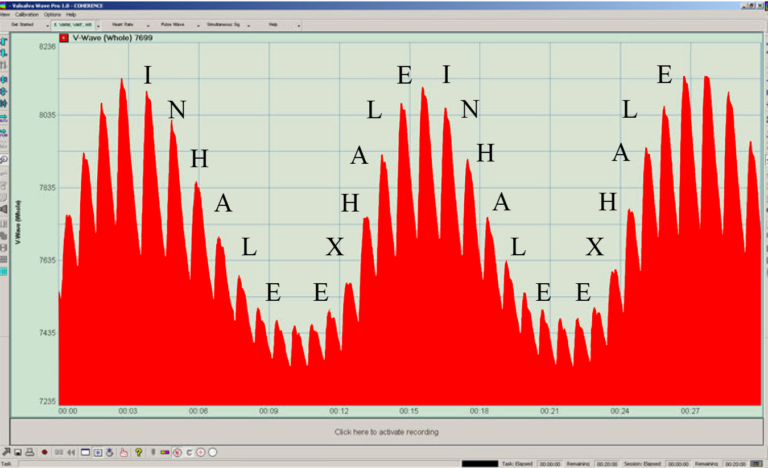
Figure 1
Figure 1 above presents the complex Valsalva Wave detected at the earlobe. There are two components: a) the respiratory component (slow red wave) resulting from the action of the thoracic pump, b) the heartbeat (autonomic response to respiratory component). It is this wave that is depicted in the graphic below, a function of diaphragm movement. The Valsalva Wave rises as we exhale and falls as we inhale, all as a function of thoracic pressure modulated by diaphragm motion.
The respiratory component is generated by the combined action of the thoracic cavity construct bounded at the bottom by the diaphragm. When the diaphragm moves down, the respiratory component viewed at the capillary circulation falls, heart rate speeding up. When the diaphragm moves up, the respiratory component rises, heart rate slowing down. The phenomenon is best monitored at the earlobe because blood activity in the head immediately follows diaphragm movement, due to large vessels and a short path between the lungs and the head. There is delay between diaphragm action and the extremities – fingers & toes.
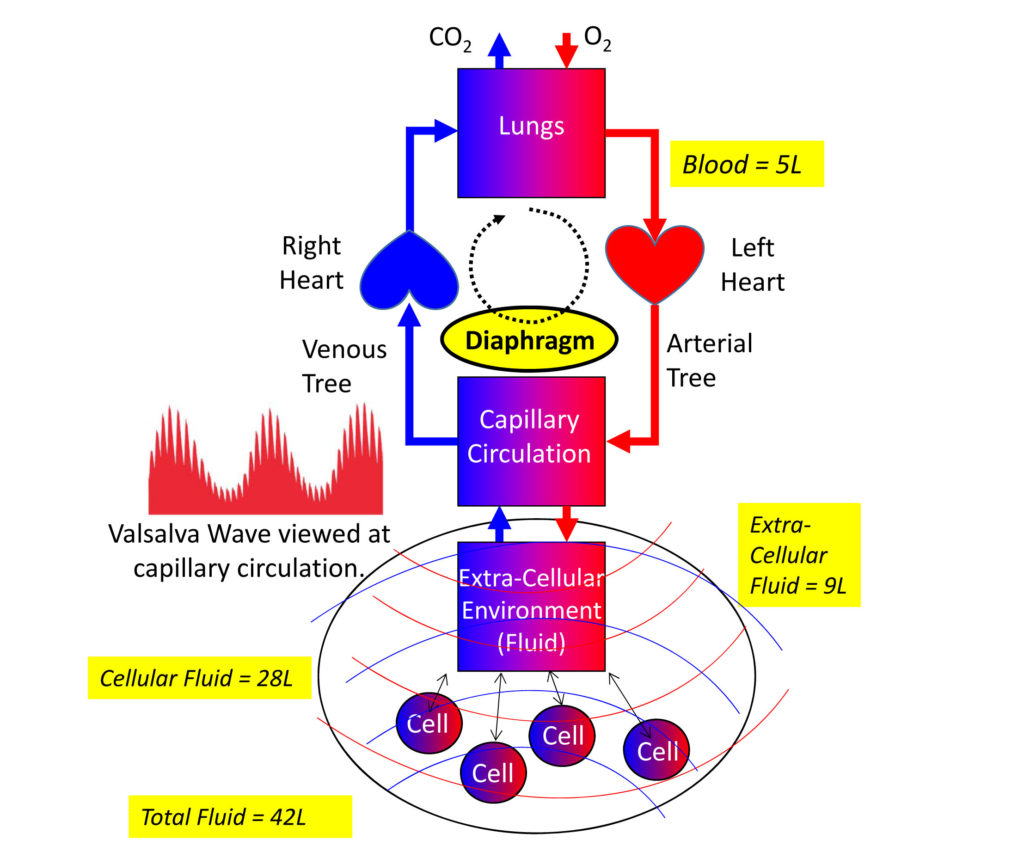
Figure 2
Valsalva Wave Pro separates the complex signal into its 2 fundamental components: a) the blood wave induced by diaphragm movement, a.k.a. the “Valsalva Wave”, and b) the heart beat (the autonomic outcome of diaphragm movement) to yield this view:
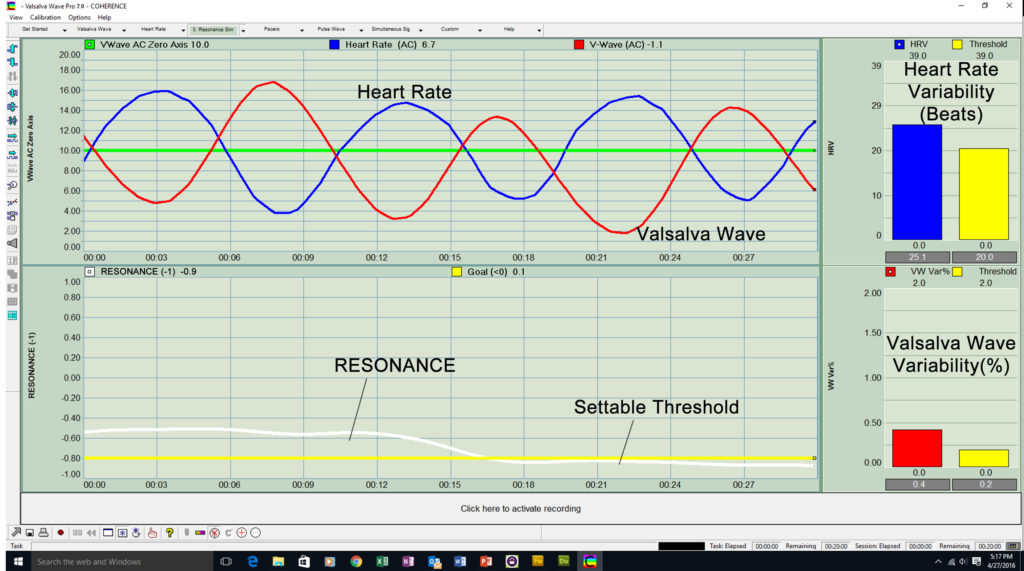
Figure 3
Valsalva Wave Pro separates the complex signal into its 2 fundamental components: a) the blood wave induced by diaphragm movement, a.k.a. the “Valsalva Wave”, and b) the heart beat (the autonomic outcome of diaphragm movement) to yield this view:
The red line is the filtered Valsalva Wave component. The blue line graphs the heart rate (HRV cycle). The heart rate (HRV cycle) is the autonomic outcome of the Valsalva Wave.
The goal of Personal Resonance Protocol is to align these phenomenon in time such that the heart rate is 180 degrees out of phase with the Valsalva Wave, indicating “perfect” resonance. At perfect resonance, circulatory efficacy is maximal, arterial and venous blood are balanced, the wave produced washes through the capillary circulation facilitating fluid exchange deep into the extra-cellular and cellular environs, in this way facilitating hydration, nutrition, and waste removal throughout the parenchyma, skin, brain, organs…
This is the evolving central value proposition of Coherent Breathing and specifically of Personal Resonance, i.e. it defines the personal unique breathing rate at which circulatory efficacy is maximal.
As circulatory health is the single largest disease challenge facing the human population, the advancement is extremely relevant to current human health
Figure 1 above presents the complex Valsalva Wave detected at the earlobe. There are two components: a) the respiratory component (slow red wave) resulting from the action of the thoracic pump, b) the heartbeat (autonomic response to respiratory component).
The respiratory component is generated by the combined action of the thoracic cavity construct bounded at the bottom by the diaphragm. When the diaphragm moves down, the respiratory component viewed at the capillary circulation falls, heart rate speeding up. When the diaphragm moves up, the respiratory component rises, heart rate slowing down. The phenomenon is best monitored at the earlobe because blood activity in the head immediately follows diaphragm movement, due to large vessels and a short path between the lungs and the head. There is delay between diaphragm action and the extremities – fingers & toes.
Valsalva Wave Pro separates the complex signal into its 2 fundamental components: a) the blood wave induced by diaphragm movement, a.k.a. the “Valsalva Wave”, and b) the heart beat (the autonomic outcome of diaphragm movement) to yield this view:
Figure 1 above presents the complex Valsalva Wave detected at the earlobe. There are two components: a) the respiratory component (slow red wave) resulting from the action of the thoracic pump, b) the heartbeat (autonomic response to respiratory component).
The respiratory component is generated by the combined action of the thoracic cavity construct bounded at the bottom by the diaphragm. When the diaphragm moves down, the respiratory component viewed at the capillary circulation falls, heart rate speeding up. When the diaphragm moves up, the respiratory component rises, heart rate slowing down. The phenomenon is best monitored at the earlobe because blood activity in the head immediately follows diaphragm movement, due to large vessels and a short path between the lungs and the head. There is delay between diaphragm action and the extremities – fingers & toes.
Valsalva Wave Pro separates the complex signal into its 2 fundamental components: a) the blood wave induced by diaphragm movement, a.k.a. the “Valsalva Wave”, and b) the heart beat (the autonomic outcome of diaphragm movement) to yield this view:
Special Discount Available For Qualified Practitioner Directory Participants (See Practitioner Directory Menu)
